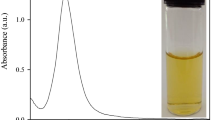Summary
The influence of Cr2O7 2−, MnO4 −, Ce4+, H2O2 and S2O8 2− as oxidising agents in lead determination as volatile covalent hydride using NaBH4 is reported in this paper.
The reaction conditions for every oxidising agents (pH, quantity and concentration of the oxidising agent, quantity and concentration of the NaBH4 and reaction time) are optimized, determining sensitivity and detection limit by measuring the peak height.
The recovery of lead from solution has been measured by flameless atomic absorption spectroscopy.
A linear relationship the logarithm of absorbance values and the redox potential of the system is obtained with a correlation coefficient of 0.999. The results and their interpretation are given in this paper.
Zusammenfassung
Es wird über den Einfluß der Oxidantien Cr2O7, MnO4 −, Ce4+, H2O2 und S2O8 2 − auf die Bleibestimmung als kovalentes Hydrid berichtet. Für jede oxidierende Substanz werden die Reaktionsbedingungen optimiert (pH, Menge und Konzentration des Oxidans, Menge und Konzentration von NaBH4 und Reaktionszeit), um Empfindlichkeit und Nachweisgrenze durch Peakhöhenauswertung zu bestimmen.
Die Wiederfindungsrate wurde durch elektrothermale Atomabsorptionsspektrometrie von Blei in der Lösung bestimmt.
Der Zusammenhang zwischen dem Logarithmus der Extinktion und dem Redoxpotential des Oxidans ergibt eine lineare Beziehung mit einem Korrelationskoeffizienten von 0.999. Die Ergebnisse und deren Interpretation werden in dieser Arbeit beschrieben.
Similar content being viewed by others
References
K. E. Thompson and D. R. Thomerson, Analyst94, 595 (1974).
H. D. Fleming and R. G. Ide, Anal. Chim. Acta83, 67 (1976).
P. N. Vijan and G. R. Wood, Analyst101, 966 (1976).
K. Jin, N. Taja, H. Yoshida, and S. Hikime, Bunseki Kagaku27, 759 (1972).
R. S. Schmidt, Atomic Spectroscopy2, 5 (1981).
J. R. Castillo, J. Lanaja, and J. Aznarez, Analyst107, 89 (1982).
J. R. Castillo, J. Lanaja, M. C. Martínez, and J. Aznárez, Analyst107, 1488 (1982).
J. R. Castillo and M. C. Martínez, Atomic Spectroscopy4, 63 (1983).
J. R. Knechtel and J. L. Fräser, Analyst103, 105 (1978).
Author information
Authors and Affiliations
Rights and permissions
About this article
Cite this article
Castillo, J.R., Mir, J.M., Martínez, C. et al. Influence of oxidising agents in lead determination by hydride generation direct flame atomic absorption spectroscopy. Mikrochim Acta 85, 253–263 (1985). https://doi.org/10.1007/BF01198298
Received:
Revised:
Issue Date:
DOI: https://doi.org/10.1007/BF01198298



